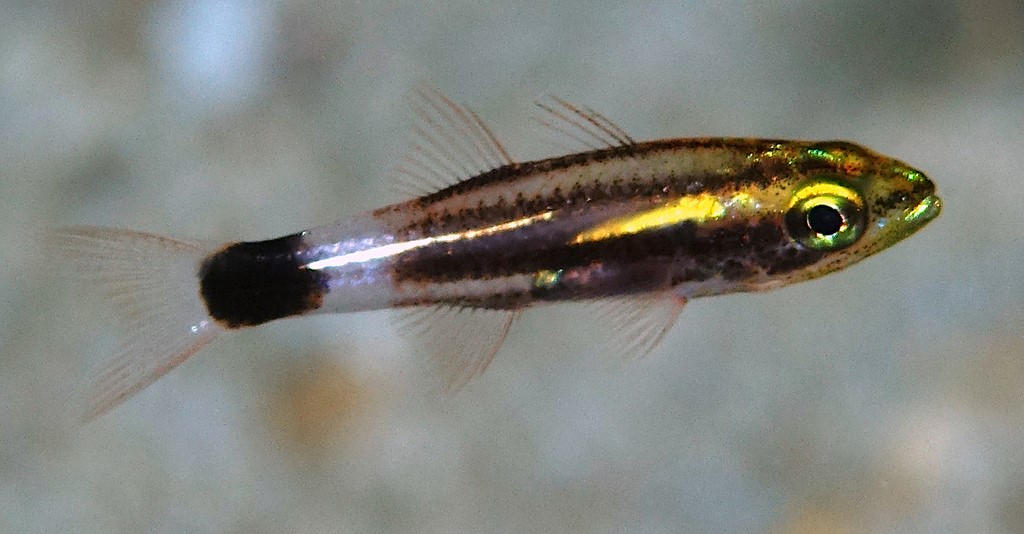CHEILODIPTERUS HEPTAZONA - (BLEEKER, 1849)
Picture courtesy of: Alain Daoulas
Actinopterygii (Gigaclass) > Actinopteri (Class) > Teleostei (Subclass) > Gobiiformes (Order) > Apogonoidei (Suborder) > Apogonidae (Family) > Apogoninae (Subfamily) > Cheilodipterus (Genus)
Apogon à grandes dents, Big-toothed cardinal, Big-toothed cardinal-fish, Big-toothed percelle, Eight-lined cardinalfish, Large toothed cardinalfish, Largetooth cardinalfish, Pacific tiger cardinalfish, Tiger cardinal, Tiger cardinalfish, Ottestribet kardinalfisk, Großzahn-Kardinalbarsch, Tiger-Kardinalbarsch, Pesce cardinale, Ryukyu-yarai-ischimochi, リュウキュウヤライイシモチ, 大目侧仔, 巨齒天竺鯛,
Description
Dorsal spines (total): 7; Dorsal soft rays (total): 9; Anal spines: 2; Anal soft rays: 8. Pectoral fin rays: 12; Pelvic fin rays: I, 5; Pored lateral line scales: 25; Predorsal scales: 6; Circumpeduncular scales: 12; Large canine-like teeth on jaws; Preopercular margin serrated. Max. length: 16.0 cm TL. Depth range: 0 - 40 m.
Color
Body white, with nine poorly defined dark brown stripes on lateral surface of body; Juveniles have a large black blotch/band on the caudal peduncle which becomes diffuse with age.
Etymology
Cheilodipterus: from Greek, cheilos = lip + from Greek, di = two + from Greek, pteron = wing, fin. Referring to extensible upper lip and to two dorsal fins.
heptazona: from Greek, hepta = seven + from Latin, zōnātus = belted, girdled, zoned. Referring to seven (actually: 8-9) longitudinal stripes on body.
Original description: Cheilodipterus heptazona, Bleeker, 1849 - Type locality: Jakarta, Java, Indonesia.
Distribution
Eastern Indian Ocean, western Pacific: Christmas Island (Indian Ocean) and Indonesia east to Papua New Guinea, south to northern Australia and New Caledonia.
Biology
Common in outer reef slopes, in caves and ledges of clear lagoon and seaward reefs, generally hovering solitarily in midwater. Adults usually in pairs or small groups comprising several pairs; Juveniles solitary or small groups. Feeds primarily on small fishes. Sexual maturity reached at about 8 cm. Mouthbrooders. Distinct pairing during courtship and spawning. Displays obligate monogamy where a one-to-one pair is established irrespective of resource abundance.
Similar species
Last update: 5, November 2022
Actinopterygii (Gigaclass) > Actinopteri (Class) > Teleostei (Subclass) > Gobiiformes (Order) > Apogonoidei (Suborder) > Apogonidae (Family) > Apogoninae (Subfamily) > Cheilodipterus (Genus)
Apogon à grandes dents, Big-toothed cardinal, Big-toothed cardinal-fish, Big-toothed percelle, Eight-lined cardinalfish, Large toothed cardinalfish, Largetooth cardinalfish, Pacific tiger cardinalfish, Tiger cardinal, Tiger cardinalfish, Ottestribet kardinalfisk, Großzahn-Kardinalbarsch, Tiger-Kardinalbarsch, Pesce cardinale, Ryukyu-yarai-ischimochi, リュウキュウヤライイシモチ, 大目侧仔, 巨齒天竺鯛,
Description
Dorsal spines (total): 7; Dorsal soft rays (total): 9; Anal spines: 2; Anal soft rays: 8. Pectoral fin rays: 12; Pelvic fin rays: I, 5; Pored lateral line scales: 25; Predorsal scales: 6; Circumpeduncular scales: 12; Large canine-like teeth on jaws; Preopercular margin serrated. Max. length: 16.0 cm TL. Depth range: 0 - 40 m.
Color
Body white, with nine poorly defined dark brown stripes on lateral surface of body; Juveniles have a large black blotch/band on the caudal peduncle which becomes diffuse with age.
Etymology
Cheilodipterus: from Greek, cheilos = lip + from Greek, di = two + from Greek, pteron = wing, fin. Referring to extensible upper lip and to two dorsal fins.
heptazona: from Greek, hepta = seven + from Latin, zōnātus = belted, girdled, zoned. Referring to seven (actually: 8-9) longitudinal stripes on body.
Original description: Cheilodipterus heptazona, Bleeker, 1849 - Type locality: Jakarta, Java, Indonesia.
Distribution
Eastern Indian Ocean, western Pacific: Christmas Island (Indian Ocean) and Indonesia east to Papua New Guinea, south to northern Australia and New Caledonia.
Biology
Common in outer reef slopes, in caves and ledges of clear lagoon and seaward reefs, generally hovering solitarily in midwater. Adults usually in pairs or small groups comprising several pairs; Juveniles solitary or small groups. Feeds primarily on small fishes. Sexual maturity reached at about 8 cm. Mouthbrooders. Distinct pairing during courtship and spawning. Displays obligate monogamy where a one-to-one pair is established irrespective of resource abundance.
Similar species
- Cheilodipterus artus (Smith, 1961) - Reported from New Caledonia - Link to the species (here).
- Cheilodipterus intermedius (Gon, 1993) - Reported from Western Pacific: Indonesia east to Papua New Guinea and Solomon Islands, north to Vietnam and Amami Islands (southern Japan), south to Great Barrier Reef (Queensland, Australia). Similar to Cheilodipterus heptazona, but caudal fin base lacks dusky bar and instead is yellow with a small black central spot, becoming whitish in large individuals. Max. length: 20.0 cm TL.
- Cheilodipterus lachneri (Klausewitz, 1959) - Reported from Red Sea, endemic.
- Cheilodipterus lineatus (Lacepède, 1801) - Reported from Red Sea; Indian Ocean: Aliwal Shoal (South Africa), East Africa, Persian Gulf, Socotra (Yemen), Seychelles, Comoros, Madagascar and Mascarenes (La Réunion, Mauritius, Rodrigues) to East of Indian Ocean. Max. length: 25.0 cm TL.
- Cheilodipterus macrodon (Lacepède, 1802) - At some stage all Cheilodipterus taxa with 8 lines where synonimised in Cheilodipterus macrodon but they clearly comprise a species-complex. Althoug this species is still valid on Eschmeyer's Catalog of Fishes, Cheilodipterus macrodon is not recognised as a species in Cadinalfishes of the world R. H. Kuiter & T. Kozawa, 2019.
Last update: 5, November 2022
